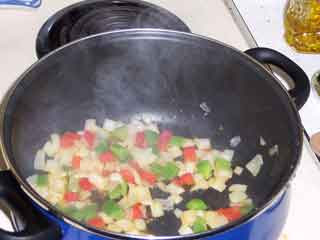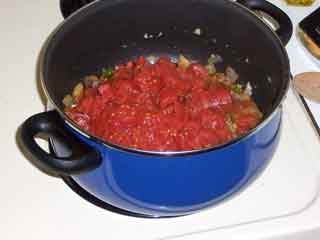I didn’t find out until I started writing up my recipes that Mostaccioli is actually the name of a pasta (“little mustaches”) rather than a dish, but, hey, who am I to stand on principle . . . Besides, I’d never found a pasta named Mostaccioli on my store shelves (until last week), so I’ve made this dish with Ziti, Penne, elbow Macaroni, Rigatoni and a few other shapes I’ve never heard of before or since! So I say, call this meal “mahstacholee” and dig in!
Here’s what you’ll need . . .
beef (ground beef, chopped beef, sliced beef, shredded beef, cubed beef, roast beef, stew beef, steak or . . .)
hot Italian sausage
onion
garlic
red pepper
green pepper
mushrooms (optional)
celery (optional)
tomatoes
white wine
bay leaf
oregano, basil,
salt
Tellicherry
sriracha
olive oil
pasta
Brown some sausage and beef in a little oil in a skillet, or a Dutch Oven big enough to hold the entire mess. You can use ground beef, or shredded beef or chopped up beef or left over steak or roast beef or, hey, if you want, make the dish with chicken or with pork or with veal (if you’re a mean heartless carnivore) or . . .

But I like beef. One time, I found an old cube steak in the freezer and an old burger. Chopped ‘em up, thawed ‘em while they browned, and the whole thing turned out great. This time, I used some frozen ground beef, a couple of sausage links and some leftover deli roast beef cut into pieces.

I like to have some chunks in the finished dish, so I usually slice up the sausage. If you’d prefer a texture more like a traditional meat sauce, slit the sausage casing and squeeze the meat out before cooking it. Same with leftovers or other cuts of meat – leave ‘em chunky for character, or shred them small for a smoother sauce.
After the meat browns (not burned – just take the red off and let the first of the fat render out), remove the meat to a plate, preserving every last drip of juice in the pan.

Also, along about here somewhere, put the pasta water on to boil.
Throw in a mess of chopped onion and let it get tender, probably 2 – 3 minutes. Then add your chopped celery, if you’re using it (I like a little bit, just for the extra flavor it adds), and cook for another minute or two. Then add the red and green peppers and cook gently for another 5 minutes or so. You want the peppers to give up the first sweetness of their flavor and that takes about 5 minutes of heat.

About 1 minute into the pepper-time, add the mushrooms, if you’re using them. And, about 3 minutes into the pepper-time, toss in a clove (or 12) of chopped garlic. (This is going to cook for at least another hour, so you can leave the garlic fairly chunky – it will get tender,)

By now the water should be boiling, so toss the pasta in and stir it around. I usually use Ziti, but any hollow tubular shaped pasta will do fine. This batch was Rigatoni because that’s what I had on hand. Cook it al dente, with a definite ‘bite’ to it. It’s going to cook into creaminess in the sauce – you just want to start it here in the water.

While the pasta cooks, add a can of whole tomatoes to the Dutch oven (or whatever pot you’re using), and break them up with the edge of your spatula.

For this batch I used a 28 oz. can of whole tomatoes (yes, Pastene), and a 28 oz. can of crushed tomatoes (also Pastene).

Add a good slug of white wine, a healthy grind or 12 of black pepper, a goodly squeeze of sriracha (about an inch long), a bay leaf or two, and maybe a handful or two of oregano, basil, and parsley (not cilantro – it’s too strong at this point – save that for serving time!)

Now stir it all around and add the meat back into your burgeoning sauce.

When the pasta is done, drain most of the water but save a ½ cup or so and toss it into the sauce with along with the pasta.

Stir it all around, put a lid on it and leave it over barely there heat for an hour or three. Yes, you can check on it from time to time, give it another stir, add some more water (or wine or beer or . . .) if it starts to dry out (but unless you keep popping the lid every five minutes, or have the heat way too hot, you shouldn’t need more liquid).

When you can’t stand the wait any longer, serve it up with tossed salad and crunchy bread.
(And if you would like a quick primer on pasta shapes and names, be sure to check out http://www.ilovepasta.org/shapes.html)
No comments:
Post a Comment